Tamarillos
are small, shrubby trees that fruit on current season’s growth. The
yield, fruit size and season of maturity can all be readily manipulated
by the time and severity of pruning.
The results
outlined in this article come from an unpublished pruning trial
conducted by Drs Greg Pringle, Kevin Patterson and Grant Thorp (now of
HortResearch) in Kerikeri during the early 1980s, and are used with
their permission.
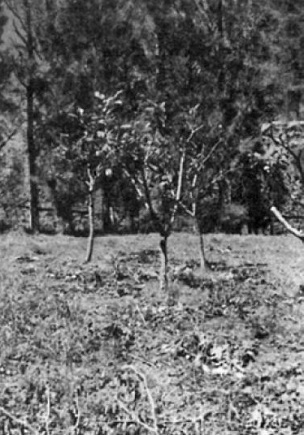
Plate
1: Moderately pruned tamarillo in a Katikati orchard
The
basic pruning strategy for tamarillos is to maintain a sturdy framework
with new growth originating from the previous season’s wood.
This
sturdy framework is important due to the brittle nature of tamarillo
wood. Compact, sturdy trees are less prone to breakage than leggy
trees, and they can also be picked satisfactorily from the ground.
It
is also important to cut back into the previous season’s wood when
pruning, as cutting into older wood gives a much more variable
response, usually being comparatively unfruitful. It is normal practice
to remove dead or broken branches at the annual spring pruning.
The
time of pruning influences the time at which the following season’s
crop will mature. After pruning, there is a period when it appears as
if nothing is happening before the new growth starts. This period is a
little longer under the lower temperatures that generally prevail in
early spring as compared to those likely to be experienced some weeks
later in mid to late spring. However, as new season’s flowers are
produced on new season’s growth, the new growth must occur before
flowers are produced, and this is influenced by the time of pruning.
It
takes approximately 20-26 weeks from fruit set to maturity, so the
earlier the fruit is set, the earlier the harvesting season is likely
to be. So early season pruning leads to an early harvesting season and
late pruning leads to a late harvesting season (Figure 4). The severity
of pruning influences the potential yield, fruit size and season of
maturity. A general principle of pruning is that the harder the cut,
the more vigorous the vegetative response is likely to be.
The
heaviest and earliest crops will be produced by unpruned trees (see
Figure 1). Light pruning gives rise to weak regrowth that branches and
sets flowers quickly and in turn leads to reasonably heavy and early
maturing crops.
Hard pruning, on the other hand, gives
rise to more vigorous regrowth, provided the tree is not cut back to
old wood. Some of these regrowths may be so vigorous they need to be
pinched out at the appropriate height to cause branching and flower
production in a tree manageable from the ground. Such vigorous regrowth
takes longer to reach the stage where flowers are produced and so has
the tendency to delay the harvest season, as compared to more moderate
pruning.
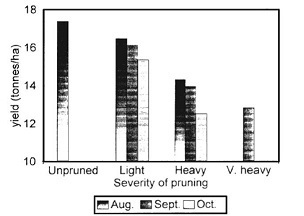
1.

Total
yield from mature tamarillo trees with pruning to different degrees and
at
different times (August 1, September 8 and October 15).
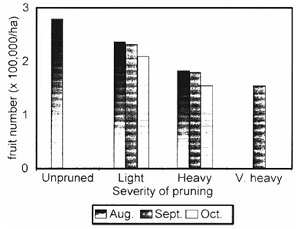
2.

Fruit
numbers from mature tamarillo trees under the same set of pruning
regimes.
Fruit
size is also affected by the severity of pruning (Figure 3). Unpruned
trees produce many fruit on weak multi-branches shoots and this gives
the potential for high fruit numbers at the expense of fruit size.
At
the other end of the scale, hard pruning leads to a small number of
more vigorous and substantial shoots which tend to produce lower
numbers of large fruit. Moderate pruning comes somewhere in between.
The response to pruning in fruit size is, of course, limited by the
genetics of the tree. It is not possible to get very large fruit from a
small fruited variety simply by hard pruning. They can only be as big
as their genetics dictate.
Water shoots have thick
green stems with long internodes. They tend to originate either from
the main trunk of from deep within the canopy. They bear few fruit and
only serve to direct the plant’s resources away from the remaining
crop. As such, they should be pruned out completely as they arise
during the growing season.
Time and severity of pruning can then be used
as a means of manipulating the yield and season of the crop as well as
fruit size.
There
may be many reasons for a grower larger fruit size. Each individual
case must be judged on its own merits and treated accordingly.
These
variations in pruning can be used to get a comparatively steady, but
very long harvesting season from April to November by pruning different
blocks over an extended period of time from early spring to early
summer. They could also be used to get either an early or late crop for
economic, management or other reasons.
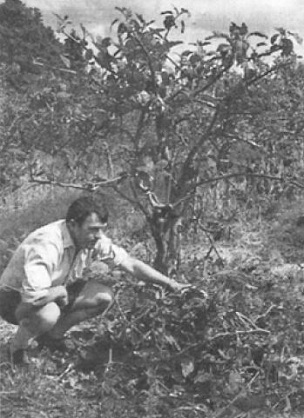
Plate 2. Moderately pruned tamarillo in a Tauranga orchard
showing the quantity of growth removed.
Returns
for tamarillos, like other seasonal crops, tend to be highest when
supplies are short at the beginning or end of the season. So an early
harvest, where a significant percentage of the crop is harvested by the
end of May , can be worthwhile.
However, to get the
most out of a very early season crop requires a lot of time in select
picking the earliest fruit to get them onto the market as early as
possible.
Over the years, it has been noted that
returns from the New Zealand market tend to be at their lowest in June
through to August, when supplies are normally heaviest. From September
onwards, prices can be expected to rise as supplies dwindle.
On
the New Zealand market, large fruit will normally get a better return
than medium or small fruit. However, with the high returns early in the
season, earliness could be expected to be more important than fruit
size at the very start of the season.
Export
requirements seem to be for a reasonable, medium-sized fruit, rather
than the very largest. This must be taken into the equation by growers
producing for export.
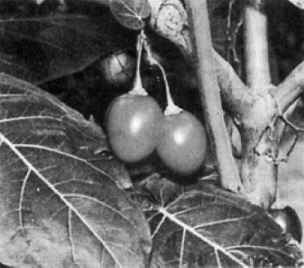
Plate 3. The response to hard pruning is vigorous growth
with a moderate number of large-sized fruit.
It
is always a good policy to keep in touch with the chosen exporter over
the specifications required, including fruit size, and if necessary
adjust the orchard management to meet them.
On sites with a greater
risk of getting a winter frost, it would be desirable to have most of
the fruit off early, before the high risk period in June and July.
It
may also be that tamarillos have to be worked into a mixed orchard
calendar and manipulating the harvest time to suit is a worthwhile
practice.
Where a grower deals with a lot of kiwifruit harvesting
from sometime in April to early June, an early tamarillo crop would be
a complication, as it could also be for growers producing a feijoas or
passionfruit. Conversely, with satsuma and Clementine mandarins that
can run on through into August, it would be more convenient to get the
tamarillos in early and be well through their season before the
mandarins get into full swing.
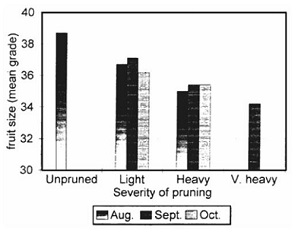
Fig. 3.

Mean
fruit size from mature tamarillo trees under various
pruning regimes. Note that higher graes equate to smaller fruit;
the very heavy pruning treatment had the largest fruit.
Yield,
fruit number, fruit size and season of maturity of tamarillos are all
affected by the timing and severity of pruning. The earliest and
heaviest yields of the smallest fruit are produced on unpruned trees.
The largest and latest maturing fruit are produced by pruning hard and
late. There are no overall recommendations, but each grower can take
this basic information and use it how it best fits into the overall
management of the orchard.
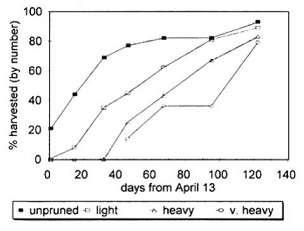
Fig. 4.

Cumulative
progression of harvest season from
September pruned trees with different degrees of pruning.
The last harvest (day 122) corresponds to August 13.
Based
on an article in the August 1996 issue of ‘The Orchardist’, magazine of
the New Zealand Fruitgrowers Federation (PO Box 2175, Wellington, New
Zealand).







